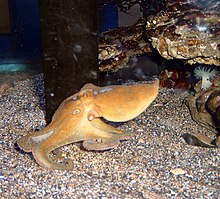California two-spot octopus
This article needs additional citations for verification. (April 2009) |
| California two-spot octopus | |
|---|---|

| |
| Octopus bimaculoides at the Santa Monica Pier Aquarium | |
| Scientific classification | |
| Kingdom: | Animalia |
| Phylum: | Mollusca |
| Class: | Cephalopoda |
| Order: | Octopoda |
| Family: | Octopodidae |
| Genus: | Octopus |
| Species: | O. bimaculoides
|
| Binomial name | |
| Octopus bimaculoides Pickford & McConnaughey, 1949[1]
| |
The California two-spot octopus (Octopus bimaculoides), often simply called a "bimac", is an octopus species native to many parts of the Pacific Ocean including the coast of California. One can identify the species by the circular blue eyespots on each side of its head. Bimacs usually live to be about two years old. They are closely related to Verrill's two-spot octopus (Octopus bimaculatus). In 2015, the genome was sequenced.[2]
Range[]
O. bimaculoides can be found in coastal waters from the intertidal down to at least 20 m (65 ft) in the eastern Pacific along mid- and southern-California and the western side of the Baja California Peninsula in Mexico.[3]
Habitat[]
This species of octopus is found in subtidal to a depth of 20 m (65 ft). It prefers rocky reefs or debris for hiding. It tolerates a wide temperature range 15-26 °C (60-80 °F)[citation needed], though it prefers 18-22 °C (65-72 °F).
Description[]
Octopus bimaculoides reaches a mantle size of 17.5 cm (7 inches) with arms to 58 cm (23 inches). Not usually heavily textured, it has several common colors, such as grey with yellow splotches, and uses highly developed crypsis (camouflage or color-changing to match the environment).
Octopuses achieve color change in part by chromatophores, iridophores, and leucophores; all are structures of the skin in increasing depth. Chromatophores are elastic pigment sacs with muscle fibers attached by which they can expand and contract. The leucophores are important because they allow for the reflection of white light and consequently allow the skin to reflect wavelengths of light which are prevalent in their habitat and produce disruptive patterns. The other aspect to cephalopod camouflage is the brain, which contains nerves coated in chromatophore fibers, controlling coloration patterning.
Distinctive features[]
This octopus gets its name from the false eye spot under each real eye. The eye spots are known as ocelli. In O. bimaculoides, the ocellus is an iridescent blue, chain-link circle set in a circle of black.
Lifespan[]
These octopuses live one to two years. The end is signaled by egg-laying in the female and senescence in both males and females.
Diet[]
Adults feed on primarily small crabs and snails, but can have a very varied clams, mussels, and diet appears to vary with location, season, and sex.[4][5] Hatchlings feed on amphipods or mysid shrimp.[6][7]
Nervous System[]
In recent years new technology, such as genome sequencing, has provided new information on the large amounts of clustered protocadherins (PCDH) in Octopus bimaculoides. The octopus was found to have 168 PCDH genes, about 120 clustered and 50 non-clustered PCDH. Unlike what has been documented about mammalian clustered PCDH, octopus PCDH are clustered around the genome in an organized manner creating a head-to-tail arrangement.[8]
References[]
- ^ Pickford, G.E.; McConnaughey, B.H. (1949). "The Octopus bimaculatus problem: a study in sibling species". Bulletin of the Bingham Oceanographic Collection. 12: 1–66.
- ^ Albertin CB, Simakov O, Mitros T, Wang ZY, Pungor JR, Edsinger-gonzales E, Brenner S, Ragsdale CW, Rokhsar DS (2015). "The octopus genome and the evolution of cephalopod neural and morphological novelties". Nature. 524: 220–224. doi:10.1038/nature14668. PMC 4795812. PMID 26268193.
- ^ Jereb, Patrizia; Roper, Clyde F. E.; Norman, Mark D.; Finn, Julian K. Cephalopods of the world. An annotated and illustrated catalogue of cephalopod species known to date. Volume 3. Octopods and Vampire Squids. p. 49.
- ^ Ambrose, Richard F. (1984-05-21). "Food preferences, prey availability, and the diet of Octopus bimaculatus Verrill". Journal of Experimental Marine Biology and Ecology. 77 (1): 29–44. doi:10.1016/0022-0981(84)90049-2. ISSN 0022-0981.
- ^ Villegas, Elisa Jeanneht Armendáriz; Ceballos-Vázquez, Bertha Patricia; Markaida, Unai; Abitia-Cárdenas, Andrés; Medina-López, Marco Antonio; Arellano-Martínez, Marcial (April 2014). "Diet of Octopus bimaculatus Verril, 1883 (Cephalopoda: Octopodidae) in Bahía De Los Ángeles, Gulf of California". Journal of Shellfish Research. 33 (1): 305–314. doi:10.2983/035.033.0129. ISSN 0730-8000.
- ^ "California Two-spot Octopus - Octopus bimaculoides". Encyclopedia of Life. Retrieved 2 October 2016.
- ^ King, Nancy. "Octopus bimaculoides Care Sheet". Retrieved 2 October 2016.
- ^ Styfhals, Ruth; Seuntjens, Eve; Simakov, Oleg; Sanges, Remo; Fiorito, Graziano (January 14, 2019). "In silico Identification and Expression of Protocadherin Gene Family in Octopus vulgaris". Frontiers in Physiology. doi:10.3389/fphys.2018.01905.
External links[]
- "CephBase: California two-spot octopus". Archived from the original on 2005.
- TONMO.com: Octopus bimaculoides Care Sheet
- eol.org: Octopus bimaculoides — Pickford and McConnaughey, 1949.
- Video of Octopus bimaculoides (California two-spot octopus)
- Octopuses
- Molluscs of the Pacific Ocean
- Cephalopods of North America
- Marine molluscs of Asia
- Western North American coastal fauna
- Fauna of California
- Fauna of the Indian Ocean
- Molluscs of Japan
- Molluscs of Oceania
- Molluscs described in 1949